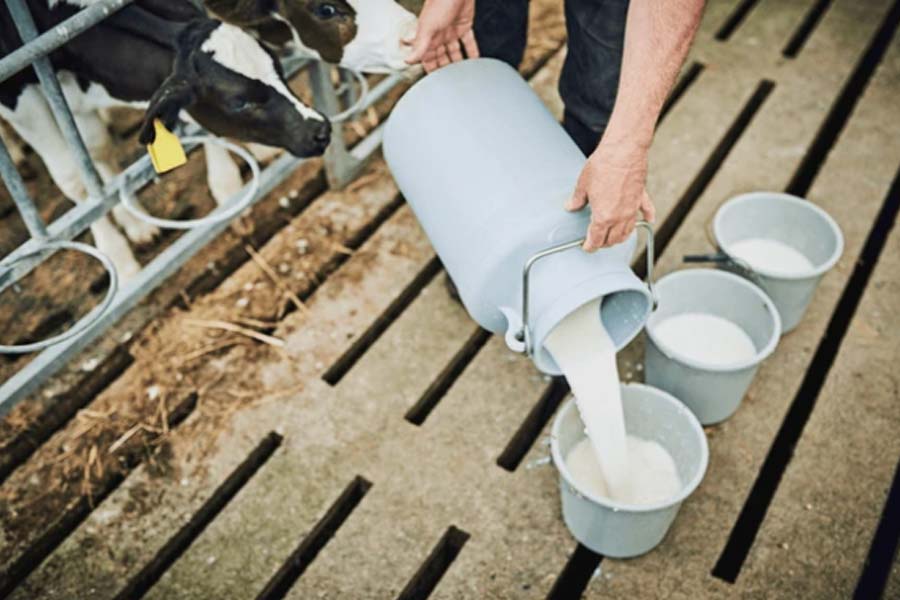The U.S. Department of Agriculture announced Friday that it would soon begin testing the country’s milk supply for H5N1, the virus that causes bird flu.
Milk has been a central concern as cases of bird flu have ticked up over the past year. Researchers believe the virus has spread between cows and to farmworkers through contaminated milk. More than 700 dairy herds have been affected by the virus, and at least 58 people, mostly farmworkers, have been sickened.
Here’s what we know about the virus and its potential impact on milk.
Why do officials want to test unpasteurized milk?
Health officials will begin testing milk from large storage tanks at dairy processing facilities, which typically pool milk from many dairy farms, before it is pasteurized. Farmers and dairy processors will also have to provide milk samples if the government requests them, and provide details to help identify more cases if a sample is positive. This testing was previously voluntary.
Testing can help officials understand which farms and cows are infected, and how the virus is moving between them, said Matthew Moore, an assistant professor in the department of food science at the University of Massachusetts, Amherst. It will also help protect farmworkers from exposure, according to the USDA.
The new testing strategy is focused on dairy processing facilities, but does not cover farms that directly process and sell their own raw milk. Regulations on raw milk farms can vary from state to state.
How much of the virus might be in raw milk?
When cows are infected with bird flu, the virus is shed in very high concentrations in their milk, said Dr. Meghan Davis, a veterinarian and environmental researcher at Johns Hopkins Bloomberg School of Public Health. Far more virus is found in their milk than in nasal swabs or blood, which may help explain why milk appears to be the main way the virus is spreading between cows and from cows to people, she said.
The virus can survive in refrigerated, unpasteurized milk for up to five weeks, according to a study published in May in the New England Journal of Medicine.
Testing has been so limited until now that scientists have not been able to get a clear picture of how much of the raw milk supply has been affected.
But this week, Raw Farm, a large supplier of raw milk products in Fresno, California, recalled raw milk and cream after bird flu was detected in retail samples. The farm is currently under quarantine and has stopped distribution of raw milk products.
Can you get bird flu from drinking raw milk?
No human cases of the virus have been linked to consuming raw milk.
We don’t have enough data yet to say whether humans can contract bird flu from drinking raw milk, said Dr. Keith Poulsen, director of the Wisconsin Veterinary Diagnostic Laboratory.
“But I wouldn’t be willing to take that risk,” he said, especially given the concentrations of virus found in raw milk. Some animals have become very ill or have died after consuming raw milk contaminated with the virus, which may also suggest a potential risk to humans.
Most people who have been infected with the virus in the United States have been healthy employees of dairy farms, who have likely been sickened from handling raw milk or having it spray in their eyes, Davis said. Even if drinking raw milk doesn’t make you sick, you might become infected in a manner similar to the workers — if you get some on your hands and then touch your eyes or nose, for example.
And though the virus has reportedly caused mild symptoms in these workers, we don’t know if it could cause more serious illness in children, older adults and those who are pregnant or immunocompromised, she added.
The Food and Drug Administration has also repeatedly warned about the risks of drinking raw milk in general. That’s because unpasteurized milk can harbor bacteria like salmonella, listeria and campylobacter. These pathogens can lead to foodborne illnesses, which can cause serious health issues or even be deadly for certain high-risk populations.
What about raw milk yogurts, kefir and cheese?
Health officials have also warned about consuming other raw milk products in general, including raw milk yogurt. It is unclear whether the fermentation process reduces the risks of H5N1 being found in kefir and yogurt, Moore said. But, like raw milk, those products can also contain other dangerous pathogens.
While the recent Raw Farm recall included only raw milk and cream, the California Department of Public Health urged people to avoid consuming any Raw Farm products, including cheese and kefir.
Is pasteurized milk safe?
Yes. Federal health agencies have stressed that the commercial supply of pasteurized milk is safe. Multiple studies have demonstrated that pasteurization, the process of heating milk for a short period of time, inactivates the virus.
“Pasteurization is key,” said Darin Detwiler, a food safety expert and professor at Northeastern University’s College of Professional Studies. “And it’s not just for bird flu.”
Can bird flu in milk make my pets sick?
Cats, dogs and other animals may fall ill with bird flu after consuming raw milk, according to the California Department of Public Health.
“If cats consume it, which we’ve seen on farms, they can get extremely ill and die,” Davis said. It’s a “huge concern” that people may feed their pets unpasteurized products contaminated with the virus, including milk or kefir sold as “pet food topper,” she said.
The New York Times News Service











